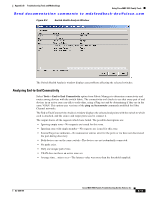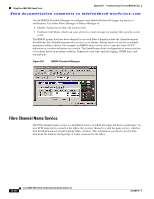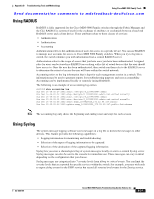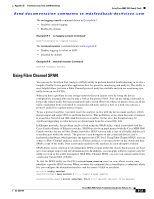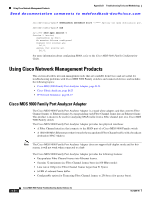Cisco MDS-9124 Troubleshooting Guide - Page 535
SCSI Target Discovery, SNMP and RMON Support
 |
View all Cisco MDS-9124 manuals
Add to My Manuals
Save this manual to your list of manuals |
Page 535 highlights
Appendix B Troubleshooting Tools and Methodology Using Cisco MDS 9000 Family Tools Send documentation comments to [email protected] SCSI Target Discovery The SCSI Target Discovery feature provides added insight into connected SCSI targets. This feature allows the switch to briefly log into connected SCSI target devices and issue a series of SCSI inquiry commands to help discover additional information. The additional information that is queried includes logical unit number (LUN) details including the number of LUNs, the LUN IDs, and the sizes of the LUNs. This information is then compiled and made available to through CLI commands, through the Cisco Fabric Manager, and also via an embedded SNMP MIB which allows the information to be easily retrieved by an upstream management application. Using the SCSI Target Discovery feature, you can have a much more detailed view of the fabric and its connected SCSI devices. The following is an example of output from the discover scsi-target command: switch# discover scsi-target local remote discovery started switch# show scsi-target lun vsan 1 - ST318203FC from SEAGATE (Rev 0004) FCID is 0xef02b5 in VSAN 1, PWWN is 21:00:00:20:37:46:78:97 LUN Capacity Status Serial Number Device-Id (MB) 0x0 18210 Online LRA2510000007027 C:1 A:0 T:3 20:00:00:20:37:46:78:97 - ST318203FC from SEAGATE (Rev 0004) FCID is 0xef02b6 in VSAN 1, PWWN is 21:00:00:20:37:5b:cf:b9 LUN Capacity Status Serial Number Device-Id (MB) 0x0 18210 Online LR94873000007029 C:1 A:0 T:3 20:00:00:20:37:5b:cf:b9 - ST318203FC from SEAGATE (Rev 0004) FCID is 0xef02b9 in VSAN 1, PWWN is 21:00:00:20:37:18:6f:90 LUN Capacity Status Serial Number Device-Id (MB) 0x0 18210 Online LR18591800001004 C:1 A:0 T:3 20:00:00:20:37:18:6f:90 For more information about SCSI target discovery, refer to the Cisco MDS 9000 Family Configuration Guide. Note This tool can be effective to find out the number of LUNs exported by a storage subsystem, but it may be ineffective when LUN Zoning/LUN Security tools are used. SNMP and RMON Support The Cisco MDS 9000 Family switches provide extensive SNMPv1, v2, and v3support, including Management Information Bases (MIBs) and notifications (traps and informs). The applications provided by Cisco that use SNMP include Fabric Manager and CiscoWorks RME. Also, the SNMP standard allows any third-party applications that support the different MIBs to manage and monitor Cisco MDS 9000 Family switches. SNMPv3 provides extended security. Each switch can be selectively enabled or disabled for SNMP service. In addition, each switch can be configured with a method of handling SNMPv1 and v2 requests. OL-9285-05 Cisco MDS 9000 Family Troubleshooting Guide, Release 3.x B-19




